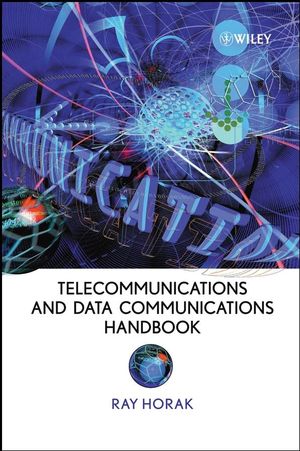Telecommunications and Data Communications Handbook, 2nd EditionISBN: 978-0-470-39607-0
Hardcover
832 pages
July 2008
 |
||||||
Acknowledgments.
About the Author.
1 FUNDAMENTALS OF THE TECHNOLOGY: CONCEPTS AND DEFINITIONS.
1.1 Fundamental Definitions.
1.2 Dedicated, Switched, and Virtual Circuits.
1.3 Two-Wire versus Four-Wire Circuits.
1.4 Bandwidth.
1.5 Analog versus Digital.
1.6 Loading Coils, Amplifiers, and Repeaters.
1.7 Conversion Process: Modems and Codecs.
1.8 Multiplexers (Muxes).
1.9 Switches and Switching: The Basics . . . and Then Some.
1.10 Signaling and Control.
References.
2 FUNDAMENTALS OF TRANSMISSION SYSTEMS: TECHNOLOGIES AND APPLICATIONS.
2.1 Electromagnetic Spectrum.
2.2 Transmission Media Selection Criteria.
2.3 Twisted Pair: Introduction to Telephone Wire.
2.4 Shielded Copper.
2.5 Coaxial Cable.
2.6 Microwave Radio.
2.7 Satellite Radio.
2.8 Free Space Optics.
2.9 Fiber Optics.
2.10 Powerline Carrier.
2.11 Hybrid Transmission Systems.
References.
3 VOICE COMMUNICATIONS SYSTEMS: KTS, PBX, CENTREX, AND ACD.
3.1 Key Telephone Systems.
3.2 Private Branch Exchanges.
3.3 Centrex.
3.4 Automatic Call Distributors.
3.5 Computer Telephony.
3.6 IP Systems.
3.7 Futures.
References.
4 MESSAGING SYSTEMS.
4.1 Facsimile (Fax) Systems.
4.2 Voice Processing Systems.
4.3 Electronic Mail (E-Mail).
4.4 Instant Messaging.
4.5 Mobile Messaging: SMS and MMS.
4.6 Unified Messaging and Unified Communications.
References.
5 PUBLIC SWITCHED TELEPHONE NETWORK.
5.1 Network Characteristics.
5.2 Numbering Plan Administration.
5.3 Domains.
5.4 Signaling and Control: Expanded View.
5.5 Network Services.
5.6 Portability: A Special Issue.
5.7 Equal Access: Another Special Issue.
5.8 VoIP: Next-Generation PSTN.
References.
6 FUNDAMENTALS OF DATA COMMUNICATIONS.
6.1 Functional Domains.
6.2 DCE: Expanded View.
6.3 Protocol Basics.
6.4 Network Architectures.
6.5 Security.
References.
7 CONVENTIONAL DIGITAL AND DATA NETWORKS.
7.1 Dataphone Digital Service.
7.2 Switched 56.
7.3 Virtual Private Networks: In the Classic Sense.
7.4 Digital Carrier Systems and Networks.
7.5 X.25 and Packet Switching.
7.6 Integrated Services Digital Network.
References.
8 LOCAL AREA NETWORKS: CONNECTIVITY AND INTERNETWORKING.
8.1 LANs Defined.
8.2 LAN Dimensions.
8.3 LAN Equipment.
8.4 LAN Operating Systems.
8.5 Virtual LANs.
8.6 Remote LAN Access.
8.7 LAN Standards and Standards Bodies.
8.8 Life in the Fast LAN: The Need for Speed.
8.9 Wireless LANs.
8.10 Minding Your Ps and Qs.
8.11 IEEE 1394 and FireWire.
8.12 Nonstandard LANs.
8.13 Broadband over Power Line.
8.14 Storage Area Networks.
References.
9 BROADBAND NETWORK INFRASTRUCTURE.
9.1 Access Technologies.
9.2 SONET/SDH.
9.3 IEEE 802.17, Resilient Packet Ring.
References.
10 BROADBAND NETWORK SERVICES.
10.1 Frame Relay.
10.2 Switched Multimegabit Data Service.
10.3 Asynchronous Transfer Mode.
10.4 Metropolitan Ethernet.
10.5 Broadband ISDN.
10.6 Advanced Intelligent Networks (AINs).
References.
11 WIRELESS NETWORKING: EMPHASIS ON MOBILITY.
11.1 Wireless Defined.
11.2 Standards and Regulations.
11.3 Advantages and Disadvantages of Wireless.
11.4 Cell Concept: Frequency Reuse.
11.5 Multiplexing and Access Techniques.
11.6 Specialized Mobile Radio.
11.7 Paging.
11.8 Cordless Telephony and Wireless Office Telecommunications Systems.
11.9 Cellular Radio.
11.10 Packet Data Radio Networks.
11.11 Satellite Systems: LEOs, MEOs, and GEOs.
11.12 And That’s Not All.
References.
12 VIDEO AND MULTIMEDIA NETWORKING.
12.1 Video Communications: Defined and Evolved.
12.2 Video Basics.
12.3 Analog TV Standards.
12.4 Digital TV and High-Definition TV.
12.5 Bandwidth and Compression.
12.6 Video Standards.
12.7 Internet Protocol TeleVision (IPTV).
12.8 The H.320 Family of Multimedia Standards.
12.9 Session Initiation Protocol.
12.10 H.248: Media Gateway Control.
12.11 Videoconferencing Systems.
12.12 Videoconferencing Equipment.
12.13 WAN Videoconferencing Networks.
12.14 Video over IP.
12.15 Multimedia Conferencing.
Applications and Benefits.
References.
13 THE INTERNET AND WORLD WIDE WEB.
13.1 The Internet Defined.
13.2 Internet Physical Topology.
13.3 Internet Access.
13.4 Internet Standards, Administration, and Regulation.
13.5 IP Addressing.
13.6 Domain Name System.
13.7 Internet Protocols.
13.8 Internet Applications.
13.10 Internet2.
13.11 World Wide Web.
13.12 Intranets and Extranets.
13.13 Internet Security: A Special Issue.
13.14 Misuse and Content.
13.15 Internet Oddities, Screwball Applications, and Some Really Good Ideas.
13.16 The Dark Side: An Editorial.
References.
14 NETWORK CONVERGENCE.
14.1 Convergence Defined.
14.2 Driving Forces.
14.3 Conventional Convergence: Wireline Networks.
14.4 The Race Is On: Mergers and Acquisitions (M&As).
14.5 One Potato, Two Potato, Three Potatoe, Four . . . .
14.6 NexGen Convergence: Wireline and Wireless Networks.
References.
15 REGULATION: ISSUES AND (SOME) ANSWERS.
15.1 Telecommunications Act of 1996.
15.2 Rates and Tariffs.
15.3 The Internet.
15.4 Number Portability.
15.5 Laws and Sausages.
References.
APPENDIX A ACRONYMS, ABBREVIATIONS, CONTRACTIONS, INITIALISMS, AND SYMBOLS.
APPENDIX B STANDARDS ORGANIZATIONS AND SPECIAL INTEREST GROUPS (SIGs).
INDEX.



